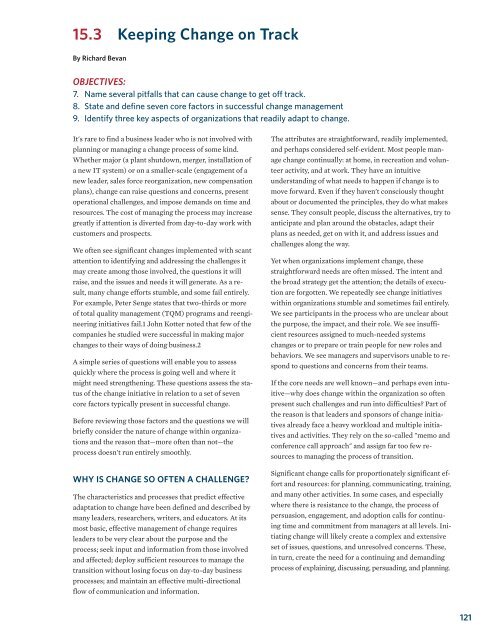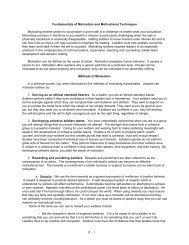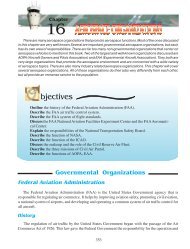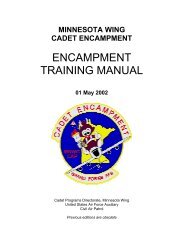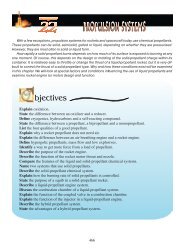LEARN TO LEAD - Civil Air Patrol
LEARN TO LEAD - Civil Air Patrol
LEARN TO LEAD - Civil Air Patrol
You also want an ePaper? Increase the reach of your titles
YUMPU automatically turns print PDFs into web optimized ePapers that Google loves.
15.3 Keeping Change on TrackBy Richard BevanOBJECTIVES:7. Name several pitfalls that can cause change to get off track.8. State and define seven core factors in successful change management9. Identify three key aspects of organizations that readily adapt to change.It's rare to find a business leader who is not involved withplanning or managing a change process of some kind.Whether major (a plant shutdown, merger, installation ofa new IT system) or on a smaller-scale (engagement of anew leader, sales force reorganization, new compensationplans), change can raise questions and concerns, presentoperational challenges, and impose demands on time andresources. The cost of managing the process may increasegreatly if attention is diverted from day-to-day work withcustomers and prospects.We often see significant changes implemented with scantattention to identifying and addressing the challenges itmay create among those involved, the questions it willraise, and the issues and needs it will generate. As a result,many change efforts stumble, and some fail entirely.For example, Peter Senge states that two-thirds or moreof total quality management (TQM) programs and reengineeringinitiatives fail.1 John Kotter noted that few of thecompanies he studied were successful in making majorchanges to their ways of doing business.2A simple series of questions will enable you to assessquickly where the process is going well and where itmight need strengthening. These questions assess the statusof the change initiative in relation to a set of sevencore factors typically present in successful change.Before reviewing those factors and the questions we willbriefly consider the nature of change within organizationsand the reason that—more often than not—theprocess doesn't run entirely smoothly.WHY IS CHANGE SO OFTEN A CHALLENGE?The characteristics and processes that predict effectiveadaptation to change have been defined and described bymany leaders, researchers, writers, and educators. At itsmost basic, effective management of change requiresleaders to be very clear about the purpose and theprocess; seek input and information from those involvedand affected; deploy sufficient resources to manage thetransition without losing focus on day-to-day businessprocesses; and maintain an effective multi-directionalflow of communication and information.The attributes are straightforward, readily implemented,and perhaps considered self-evident. Most people managechange continually: at home, in recreation and volunteeractivity, and at work. They have an intuitiveunderstanding of what needs to happen if change is tomove forward. Even if they haven't consciously thoughtabout or documented the principles, they do what makessense. They consult people, discuss the alternatives, try toanticipate and plan around the obstacles, adapt theirplans as needed, get on with it, and address issues andchallenges along the way.Yet when organizations implement change, thesestraightforward needs are often missed. The intent andthe broad strategy get the attention; the details of executionare forgotten. We repeatedly see change initiativeswithin organizations stumble and sometimes fail entirely.We see participants in the process who are unclear aboutthe purpose, the impact, and their role. We see insufficientresources assigned to much-needed systemschanges or to prepare or train people for new roles andbehaviors. We see managers and supervisors unable to respondto questions and concerns from their teams.If the core needs are well known—and perhaps even intuitive—whydoes change within the organization so oftenpresent such challenges and run into difficulties? Part ofthe reason is that leaders and sponsors of change initiativesalready face a heavy workload and multiple initiativesand activities. They rely on the so-called "memo andconference call approach" and assign far too few resourcesto managing the process of transition.Significant change calls for proportionately significant effortand resources: for planning, communicating, training,and many other activities. In some cases, and especiallywhere there is resistance to the change, the process ofpersuasion, engagement, and adoption calls for continuingtime and commitment from managers at all levels. Initiatingchange will likely create a complex and extensiveset of issues, questions, and unresolved concerns. These,in turn, create the need for a continuing and demandingprocess of explaining, discussing, persuading, and planning.121


